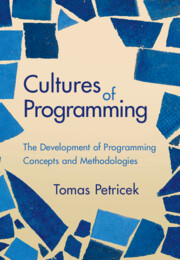Refine search
Actions for selected content:
5913 results in Programming Languages and Applied Logic

Games on Graphs
- From Logic and Automata to Algorithms
- Coming soon
-
- Expected online publication date:
- April 2026
- Print publication:
- 30 April 2026
-
- Book
- Export citation

Formal Methods, Informally
- How to Write Programs That Work
- Coming soon
-
- Expected online publication date:
- February 2026
- Print publication:
- 31 January 2026
-
- Textbook
- Export citation

Computable Structure Theory
- Beyond the Arithmetic
- Coming soon
-
- Expected online publication date:
- January 2026
- Print publication:
- 31 January 2026
-
- Book
- Export citation
1 - Introduction
-
- Book:
- Cultures of Programming
- Published online:
- 19 December 2025
- Print publication:
- 08 January 2026, pp 1-32
-
- Chapter
-
- You have access
- Open access
- Export citation
2 - Mathematisation of Programming
-
- Book:
- Cultures of Programming
- Published online:
- 19 December 2025
- Print publication:
- 08 January 2026, pp 33-76
-
- Chapter
-
- You have access
- Open access
- Export citation
3 - Interactive Programming
-
- Book:
- Cultures of Programming
- Published online:
- 19 December 2025
- Print publication:
- 08 January 2026, pp 77-131
-
- Chapter
-
- You have access
- Open access
- Export citation
5 - Programming with Types
-
- Book:
- Cultures of Programming
- Published online:
- 19 December 2025
- Print publication:
- 08 January 2026, pp 191-235
-
- Chapter
-
- You have access
- Open access
- Export citation
Preface
-
- Book:
- Cultures of Programming
- Published online:
- 19 December 2025
- Print publication:
- 08 January 2026, pp ix-xi
-
- Chapter
-
- You have access
- Open access
- Export citation
Acknowledgements
-
- Book:
- Cultures of Programming
- Published online:
- 19 December 2025
- Print publication:
- 08 January 2026, pp xii-xiv
-
- Chapter
-
- You have access
- Open access
- Export citation
6 - Object-Oriented Programming
-
- Book:
- Cultures of Programming
- Published online:
- 19 December 2025
- Print publication:
- 08 January 2026, pp 236-284
-
- Chapter
-
- You have access
- Open access
- Export citation
7 - Conclusion: Cultures of Programming
-
- Book:
- Cultures of Programming
- Published online:
- 19 December 2025
- Print publication:
- 08 January 2026, pp 285-308
-
- Chapter
-
- You have access
- Open access
- Export citation
Frontmatter
-
- Book:
- Cultures of Programming
- Published online:
- 19 December 2025
- Print publication:
- 08 January 2026, pp i-iv
-
- Chapter
-
- You have access
- Open access
- Export citation
4 - Software Engineering
-
- Book:
- Cultures of Programming
- Published online:
- 19 December 2025
- Print publication:
- 08 January 2026, pp 132-190
-
- Chapter
-
- You have access
- Open access
- Export citation
Contents
-
- Book:
- Cultures of Programming
- Published online:
- 19 December 2025
- Print publication:
- 08 January 2026, pp v-viii
-
- Chapter
-
- You have access
- Open access
- Export citation
Index
-
- Book:
- Cultures of Programming
- Published online:
- 19 December 2025
- Print publication:
- 08 January 2026, pp 332-352
-
- Chapter
-
- You have access
- Open access
- Export citation
References
-
- Book:
- Cultures of Programming
- Published online:
- 19 December 2025
- Print publication:
- 08 January 2026, pp 309-331
-
- Chapter
-
- You have access
- Open access
- Export citation

Cultures of Programming
- The Development of Programming Concepts and Methodologies
-
- Published online:
- 19 December 2025
- Print publication:
- 08 January 2026
-
- Book
-
- You have access
- Open access
- Export citation
11 - Collection Analysis for Horn Clauses
-
- Book:
- Proof Theory and Logic Programming
- Published online:
- 01 December 2025
- Print publication:
- 18 December 2025, pp 229-244
-
- Chapter
- Export citation
6 - Linear Logic
-
- Book:
- Proof Theory and Logic Programming
- Published online:
- 01 December 2025
- Print publication:
- 18 December 2025, pp 107-142
-
- Chapter
- Export citation
Solutions to Selected Exercises
-
- Book:
- Proof Theory and Logic Programming
- Published online:
- 01 December 2025
- Print publication:
- 18 December 2025, pp 280-295
-
- Chapter
- Export citation
